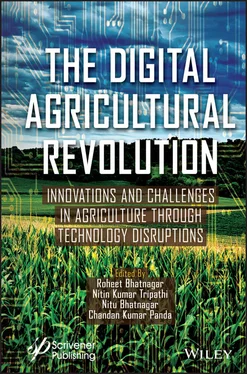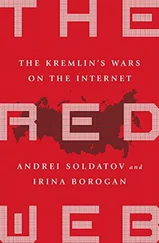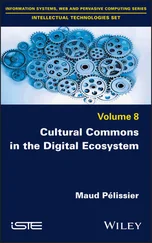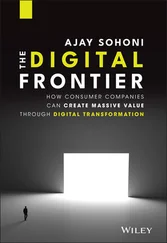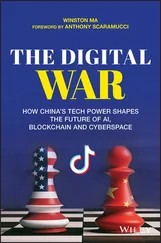The Digital Agricultural Revolution
Здесь есть возможность читать онлайн «The Digital Agricultural Revolution» — ознакомительный отрывок электронной книги совершенно бесплатно, а после прочтения отрывка купить полную версию. В некоторых случаях можно слушать аудио, скачать через торрент в формате fb2 и присутствует краткое содержание. Жанр: unrecognised, на английском языке. Описание произведения, (предисловие) а так же отзывы посетителей доступны на портале библиотеки ЛибКат.
- Название:The Digital Agricultural Revolution
- Автор:
- Жанр:
- Год:неизвестен
- ISBN:нет данных
- Рейтинг книги:5 / 5. Голосов: 1
-
Избранное:Добавить в избранное
- Отзывы:
-
Ваша оценка:
- 100
- 1
- 2
- 3
- 4
- 5
The Digital Agricultural Revolution: краткое содержание, описание и аннотация
Предлагаем к чтению аннотацию, описание, краткое содержание или предисловие (зависит от того, что написал сам автор книги «The Digital Agricultural Revolution»). Если вы не нашли необходимую информацию о книге — напишите в комментариях, мы постараемся отыскать её.
The book integrates computational intelligence, applied artificial intelligence, and modern agricultural practices and will appeal to scientists, agriculturists, and those in plant and crop science management.
IoT and Big Data Analytics Applications in Agriculture
Robotics & Automation in Agriculture Systems
Intelligent and Innovative Smart Agriculture Applications
Privacy, Security, and Trust in Digital Agriculture
Open Problems, Challenges, and Future Trends.
Audience
The Digital Agricultural Revolution — читать онлайн ознакомительный отрывок
Ниже представлен текст книги, разбитый по страницам. Система сохранения места последней прочитанной страницы, позволяет с удобством читать онлайн бесплатно книгу «The Digital Agricultural Revolution», без необходимости каждый раз заново искать на чём Вы остановились. Поставьте закладку, и сможете в любой момент перейти на страницу, на которой закончили чтение.
Интервал:
Закладка:
– Chapter 8discusses how modern agriculture has become knowledge intensive and how improved access to and availability of information and communication technologies (ICTs), especially cell phones, computers, radio, internet, and social media, has created many more opportunities for multi-format information gathering, processing, storage, retrieval, management and sharing.
– Chapter 9presents an overview of nanotechnology and nanosensors in forestry and agriculture, including its use in forest health protection, forest management, wood and paper processing, and chemotaxonomy. The nanotechnology sector has best applied this technology in precision farming by developing nanobionic plants by inserting nanosensors into living plants that can be utilized to communicate as infrared devices and for sensing objects in the plant’s environment. Therefore, the nanobionics approach has opened a new vista into plant nanomaterial research. Some nanobionics approaches for agriculture and forestry development are also briefly discussed.
– Chapter 10is all about mathematical models of the water resources management process of canals in the middle reaches of the Chirchik River, which were developed using simplified differential equations of Saint Venant in partial derivatives to model the necessary conditions for optimizing water distribution. An algorithm for solving the problem of optimal water resources management of distributed irrigation canals was also developed.
– Chapter 11discusses various principles of reengineering of agricultural resources and throws light on open problems, challenges, and future trends.
– Chapter 12shows how the supply chain management method is used for planning maintenance strategy, storing products, moving material through the organization and its distribution channel, which leads directly to maximum profits through cost-saving fulfilment of orders. A simple supply chain acts as a bridge between demand and supply. Startups are bringing a new shape to the agri-supply chain by using new-age technologies like AI, machine learning, IoT and blockchain management, that procure directly from farm gates and supply to retailers.
– Chapter 13discusses the need for an institutional approach of using digital techniques in modern agrarian production. This approach is illustrative of the synergy of economic, ecological, and social effectiveness as a progressive direction in which the development of a global economic system can be worked out. A general model was used to determine a new organization of the informational paradigm of agricultural activities based on the agility of the knowledge and analytical data being transferred into the value of information.
– Chapter 14provides a comprehensive analysis of four aspects of AI implementation in treatment of wastewater: management, technology, reuse and economics of wastewater. It also provides an insight into the future prospects of the use of AI in the treatment of wastewater, which, in complex practical applications, simultaneously addresses pollutant removal, water reuse and management and cost-efficient challenges.
– Chapter 15presents methods for assessing the impact of digital transformation risks on the business model of agricultural enterprises. Industry 4.0 is accompanied by the rapid transformation of several sectors under the influence of “breakthrough” digital innovations such as blockchain, IoT, AI, and augmented reality.
– Chapter 16presents a unified systematic approach to the issue of modeling the dynamics of water management facilities. There is a wide range of mathematical models of individual objects of different complexity, which is why the choice of mathematical models that will describe the complex processes of water distribution in water management systems with the required degree of accuracy is a very problematic task.
– Chapter 17showcases the use of blockchain technology that has become a phenomenon in recent years and is evolving into a form that institutionalized organizations can benefit from. The IoT integrates blockchain technology into the agricultural sector and provides the automation of the control mechanisms in the agricultural food supply chain. The study evaluated in this chapter utilizes technology in various forms, from farm to fork. Furthermore, a Fintech solution framework via blockchain created for digitalization of the agricultural commodity value chain is presented that secures the contract creation, transfer, and redemption (burn) processes.
– Chapter 18discusses how new-age entrepreneurs are using technological innovations to address supply chain challenges and unlock value across it. India’s startup agricultural ecosystem is mushrooming, with over 450 startups that are currently operational, over 50% of which are focused on making the supply chain more efficient by improving market linkages. Inputs play a crucial role in extracting higher yields. The existing delivery system is not appropriate due to poor supply, lack of subsidies, improper infrastructure, lack of farm credit, and poor delivery systems.
– Chapter 19is about the adoption of blockchain technology in the Malaysian agriculture sector and proposes a framework of blockchain agriculture supply chain management. As the blockchain supply chain framework in the agriculture sector is still limited, social network theory tends to be used in the development of the framework. This chapter has collected quantitative survey and social network data from firms registered in the Federation of Malaysian Manufacturers that operate in the agriculture sector. The demographic profiles were analyzed through IBM SPSS 26 and the social network data was analyzed through Social Network Visualizer.
– Chapter 20discusses the use of machine learning algorithms to study soil fertility, salinity, dynamics, and the relationship of soil organic carbon with the environment, spatial and temporal variation of soil water content, soil and water pollution, soil formation processes, soil classification, prediction, nutrient availability, etc.
Our intent in writing this book was to provide a foundation of comprehensive knowledge for others to build on; therefore, it is our sincerest hope that it will prove to be beneficial to people from different domains. We hope that you find it useful and engaging as you continue your journey to expand the sphere of human knowledge, if only by an inch.
We are thankful to all the authors and co-authors of every chapter who have contributed their knowledge in the form of quality manuscripts for the benefit of others.
The editorsDr. Roheet BhatnagarDr. Nitin Kumar TripathiDr. Chandan Kumar PandaDr. Nitu BhatnagarApril 2022
1
Scope and Recent Trends of Artificial Intelligence in Indian Agriculture
X. Anitha Mary1, Vladimir Popov2,3, Kumudha Raimond4, I. Johnson5 and S. J. Vijay6*
1Department of Robotics Engineering, Karunya Institute of Technology and Sciences, Coimbatore, Tamil Nadu, India
2Additive Manufacturing, Technion-Israel Institute of Technology, Haifa, Israel
3Ural Federal University, Ekaterinburg, Russia
4Department of Computer Science and Engineering, Karunya Institute of Technology and Sciences, Coimbatore, Tamil Nadu, India
5Department of Plant Pathology, TamilNadu Agricultural University, Coimbatore, India
6Department of Mechanical Engineering, Karunya Institute of Technology and Sciences, Coimbatore, Tamil Nadu, India
Abstract
Agriculture is the economic backbone of India. About 6.4% of the total world’s economy relies on agriculture [1]. Automation in agriculture is the emerging sector as there is an increase in food demand and employment. The traditional ways used by farmers are not sufficient to fulfill the demands and it is high time that newer technologies are implementing in the agricultural sector. Artificial Intelligence (AI) is one of the emerging and promising technologies where intelligence refers to developing and utilizing human-level thinking machines through learning algorithms programmed to solve critical problems. Artificial Intelligence plays an important role in supporting agriculture sectors with the objectives of boosting productivity, efficiency, and farmers’ income. This chapter focuses on how AI helps in increasing the socioeconomic and environmental sustainability in the Indian agricultural sector. Also, it highlights the AI practices in India incorporated by farmers having small and medium-size agricultural lands.
Читать дальшеИнтервал:
Закладка:
Похожие книги на «The Digital Agricultural Revolution»
Представляем Вашему вниманию похожие книги на «The Digital Agricultural Revolution» списком для выбора. Мы отобрали схожую по названию и смыслу литературу в надежде предоставить читателям больше вариантов отыскать новые, интересные, ещё непрочитанные произведения.
Обсуждение, отзывы о книге «The Digital Agricultural Revolution» и просто собственные мнения читателей. Оставьте ваши комментарии, напишите, что Вы думаете о произведении, его смысле или главных героях. Укажите что конкретно понравилось, а что нет, и почему Вы так считаете.
